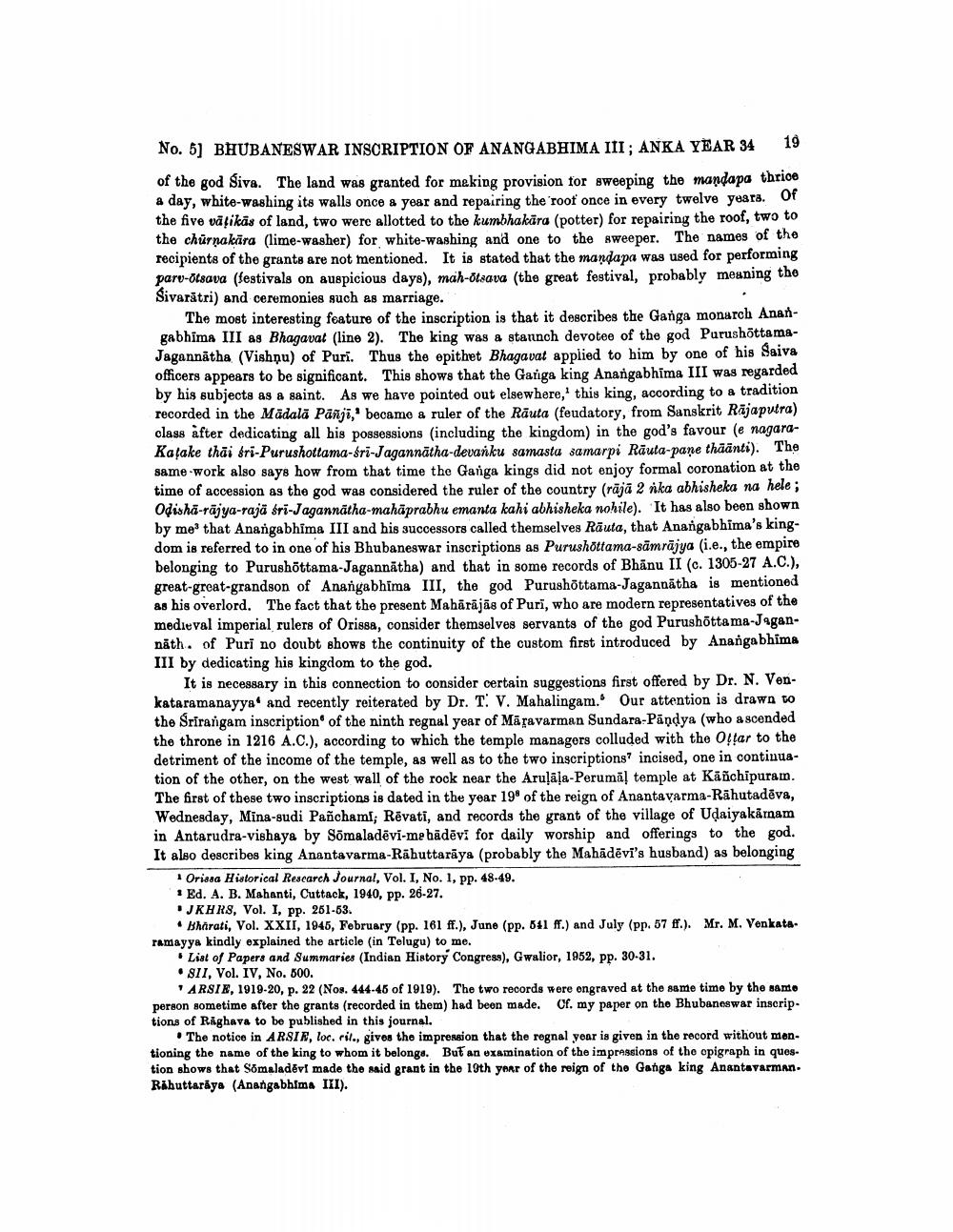________________
No. 5] BHUBANESWAR INSCRIPTION OF ANANGABHIMA III; ANKA YEAR 34
19
of the god Siva. The land was granted for making provision for sweeping the mandapa thrice a day, white-washing its walls once a year and repairing the roof once in every twelve years. Of the five välikäs of land, two were allotted to the kumbhakara (potter) for repairing the roof, two to the churņakära (lime-washer) for white-washing and one to the sweeper. The names of the recipients of the grants are not mentioned. It is stated that the mandapa was used for performing parv-otsava (festivals on auspicious days), mah-otsava (the great festival, probably meaning the Sivaratri) and ceremonies such as marriage.
The most interesting feature of the inscription is that it describes the Ganga monarch Anangabhima III as Bhagavat (line 2). The king was a staunch devotee of the god PurushottamaJagannatha (Vishnu) of Puri. Thus the epithet Bhagavat applied to him by one of his Saiva officers appears to be significant. This shows that the Ganga king Anangabhima III was regarded by his subjects as a saint. As we have pointed out elsewhere,' this king, according to a tradition recorded in the Madala Pañji, became a ruler of the Räuta (feudatory, from Sanskrit Rajaputra) class after dedicating all his possessions (including the kingdom) in the god's favour (e nagaraKatake thai bri-Purushottama-sri-Jagannatha-devanku samasta samarpi Rauta-pane thaanti). The same work also says how from that time the Ganga kings did not enjoy formal coronation at the time of accession as the god was considered the ruler of the country (räjä 2 nka abhisheka na hele; Odisha-rajya-raja śri-Jagannatha-mahaprabhu emanta kahi abhisheka nohile). It has also been shown by me that Anangabhima III and his successors called themselves Rauta, that Anangabhima's kingdom is referred to in one of his Bhubaneswar inscriptions as Purushottama-sämrajya (i.e., the empire belonging to Purushottama-Jagannatha) and that in some records of Bhanu II (c. 1305-27 A.C.), great-great-grandson of Anangabhima III, the god Purushottama-Jagannatha is mentioned as his overlord. The fact that the present Mahārājās of Puri, who are modern representatives of the medieval imperial rulers of Orissa, consider themselves servants of the god Purushottama-Jagannath. of Puri no doubt shows the continuity of the custom first introduced by Anangabhima III by dedicating his kingdom to the god.
It is necessary in this connection to consider certain suggestions first offered by Dr. N. Venkataramanayya and recently reiterated by Dr. T. V. Mahalingam. Our attention is drawn to the Srirangam inscription of the ninth regnal year of Maravarman Sundara-Pandya (who ascended the throne in 1216 A.C.), according to which the temple managers colluded with the Oṭṭar to the detriment of the income of the temple, as well as to the two inscriptions? incised, one in continuation of the other, on the west wall of the rock near the Arulala-Perumal temple at Käñchipuram. The first of these two inscriptions is dated in the year 19° of the reign of Anantavarma-Rahutadeva, Wednesday, Mina-sudi Panchami; Revati, and records the grant of the village of Uḍaiyakamam in Antarudra-vishaya by Sōmaladevi-me hādēvi for daily worship and offerings to the god. It also describes king Anantavarma-Rahuttaraya (probably the Mahādēvi's husband) as belonging
1 Orissa Historical Research Journal, Vol. I, No. 1, pp. 48-49.
Ed. A. B. Mahanti, Cuttack, 1940, pp. 26-27.
JKHRS, Vol. I, pp. 251-53.
Bharati, Vol. XXII, 1945, February (pp. 161 ff.), June (pp. 541 ff.) and July (pp. 57 ff.). Mr. M. Venkata. ramayya kindly explained the article (in Telugu) to me.
List of Papers and Summaries (Indian History Congress), Gwalior, 1952, pp. 30-31.
SII, Vol. IV, No. 500.
ARSIE, 1919-20, p. 22 (Nos. 444-45 of 1919). The two records were engraved at the same time by the same person sometime after the grants (recorded in them) had been made. Cf. my paper on the Bhubaneswar inscriptions of Raghava to be published in this journal.
The notice in ARSIE, loc. rit., gives the impression that the regnal year is given in the record without mentioning the name of the king to whom it belongs. But an examination of the impressions of the epigraph in question shows that Sōmaladevi made the said grant in the 19th year of the reign of the Ganga king Anantavarman. Rahuttaraya (Anangabhima III).




